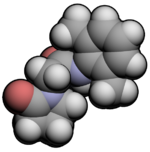Nefiracetam
 |
|
 |
|
| Clinical data | |
|---|---|
| Routes of administration |
Oral |
| ATC code |
|
| Legal status | |
| Legal status |
|
| Pharmacokinetic data | |
| Biological half-life | 3-5 hours |
| Identifiers | |
|
|
| CAS Number | |
| PubChem CID | |
| ChemSpider | |
| UNII | |
| ChEMBL | |
| ECHA InfoCard | 100.163.910 |
| Chemical and physical data | |
| Formula | C14H18N2O2 |
| Molar mass | 246.305 g/mol |
| 3D model (Jmol) | |
|
|
|
|
|
|
|
Nefiracetam is a nootropic antidementia drug of the racetam family.
Nefiracetam's cytoprotective actions are mediated by enhancement of GABAergic, cholinergic, and monoaminergic neuronal systems. It has been shown to effectively treat apathy and improve motivation in post-stroke patients. It has been shown to exhibit antiamnesia effects for the Alzheimer's type and cerebrovascular type of dementia. In addition, it has also been shown to have antiamnesia effects against a wide variety of memory impairing substances, including: ethanol, chlorodiazepoxide (Librium), scopolamine, bicuculline, picrotoxin, and cycloheximide.
Studies of long term consumption of nefiracetam in humans and primates have shown it to have no toxicity. However, animals which metabolize nefiracetam differently from humans and primates are at risk for renal and testicular toxicity. Dogs especially are particularly sensitive, which has been shown to be caused by a specific metabolite, M-18. Higher doses than those in dogs were needed to cause testicular toxicity in rats, although no toxicity was seen in monkeys. Additionally, there has been no evidence of toxicity during clinical trials.
...
Wikipedia
